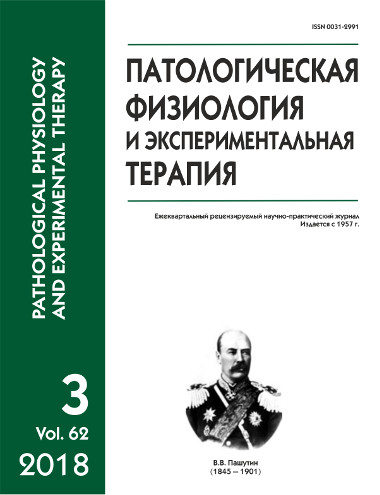Significance of integral hematological indexes for predicting postoperative wound healing in the experiment
Abstract
The article presents results of predicting the wound healing process using integral hematological indexes. The aim of the study was to describe the dynamics of integral hematological indexes of wound healing process in rats to predict its outcome. The study included 297 white mongrel male rats weighing 190—210 g, which were divided into three groups, 99 rats in each. One group was a control group; in the second group, a wound healing process with abdominal wall tension was modeled; in the third group, a wound healing process with a graft was modeled. The following integrated hematological indexes were determined: Krebs index; Bredeck index; leukocyte index; neutrophil/monocyte ratio; lymphocyte/monocyte ratio; lymphocyte/eosinophil ratio; albumin/globulin ratio; and oxyproline coefficient. The study showed that changes in values of integral hematological indexes were mostly statistically and clinically significant. We concluded that changes in integral hematological indexes in different models of wound healing reflect nonspecific and specific protective responses of the body as a whole and allow to predict further course and outcome of the wound healing process.
Downloads
References
2. Zhigulina, V.V. Biochemical response to stress (literature review). Verhnevolzhskiy meditsinskiy zhurnal. 2014; 4: 25-30. (in Russian)
3. Fetisov, V.A., Krivokorytov A.L., Kostyaev A.A., Shevchenko A.A., Durova V.V., Lobastov A.V., Gaar E.V. Actual issues of managing the wound process in its pathology. Vyatskiy meditsinskiy vestnik. 2001; 1: 26-7. (in Russian)
4. Maslyakov V.V., Sukhanovа O.A., Barsukov V.G. and others Possibilities of correcting the rheological properties of blood in stab-cut wounds of the chest (short message). Patologicheskaya fiziologiya i eksperimental’naya terapiya. 2017; 61(2): 72-5. (in Russian)
5. Gusak, V.K., Fistal’ EH.YA., Speranskiji I.I. and others. Evaluation of the severity of endogenous intoxication and the choice of the method of detoxification therapy in feces leukocytograms and biochemical monitoring. Klinicheskaya laboratornaya diagnostika. 2000; 10: 36. (in Russian)
6. Shcherba S.N., Bensman V.M., Savchenko Yu.P., Manujlov A.M., Karipida A.M., Avakimyan G.K. The method of early combined prediction of development of suppuration of postoperative wounds in the preclinical phase. Kubanskiy nauchnyy meditsinskiy vestnik. 2015; 6(155): 138-41. (in Russian)
7. Litvickij, P.F. Pathology of the hemostatic system. Voprosy sovremennoy pediatrii. 2014; 13(2): 65-76. (in Russian)
8. Gluhov A.A., Aralova M.V. Pathophysiology of long-term non-healing wounds and modern methods of stimulation of the wound process. Novosti khirurgii. 2015; 23 (6): 673-9. (in Russian)
9. Handbook of clinical laboratory research methods. [Spravochnik po klinicheskim laboratornym metodam issledovaniyam]. Ed. E.A. Kosta. Moscow; Meditsina, 1975.






